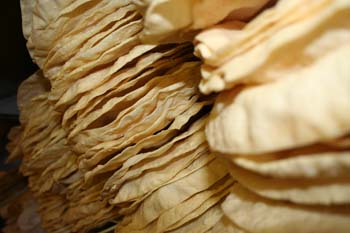
The term “poppadom,” also spelled “papadum” or “papad,” refers to a thin, crisp disc-shaped Indian flatbread made primarily from seasoned lentil or chickpea flour. This versatile and popular accompaniment to many South Asian meals has a complex etymology and a variety of spellings that reflect its cultural diversity and historical evolution.
The word “poppadom” itself is widely used in British English to describe this crunchy delicacy. However, alternate spellings such as “papadum” and “papad” are also prevalent. These variations often stem from regional differences in pronunciation and transliteration, highlighting the linguistic diversity of the Indian subcontinent.
The origin of the word “poppadom” can be traced back to the Tamil language, spoken predominantly in the Indian state of Tamil Nadu and parts of Sri Lanka. In Tamil, the term “pappāṭam” (பப்பாடம்) refers to a thin, round-shaped wafer made from lentil or chickpea flour, seasoned with various spices and then dried. The Tamil word has been adopted into English, albeit with variations in spelling.
Beyond Tamil, similar flatbreads are known by different names in various Indian languages. In Hindi, the term “papad” is commonly used, while in Kannada, it is referred to as “happala.” These linguistic nuances are reflective of the rich linguistic tapestry of the Indian subcontinent, where each region has its own language and dialects.
The preparation and consumption of poppadoms have a long history in South Asian cuisine, with evidence suggesting their existence as far back as 2000 BCE. The traditional method of making poppadoms involves creating a paste from lentil or chickpea flour, shaping it into thin discs, and then allowing them to dry in the sun. Modern manufacturing processes may involve mechanized techniques, but the essence of the preparation remains consistent.
Poppadoms are known for their versatility and are often served as an accompaniment to meals. They can be roasted, fried, or microwaved, resulting in a crispy and flavorful side dish that complements a wide array of main courses. The choice of spices and additional ingredients may vary, contributing to the diverse regional variations in taste and texture.
In Indian households, making poppadoms from scratch is considered an art, and recipes are often passed down through generations. The process involves a meticulous blend of lentil or chickpea flour, spices such as cumin and black pepper, and water to form a smooth dough. This dough is then rolled into thin sheets, cut into discs, and left to dry before being cooked to perfection.
The popularity of poppadoms extends beyond South Asia, finding its way into the international culinary scene. Indian restaurants around the world feature poppadoms as a popular appetizer or snack, often served with various chutneys, pickles, or yogurt-based dips.
The widespread acceptance of poppadoms in global cuisine underscores the impact of Indian culinary traditions on the world stage. The variations in spelling, such as “papadum” or “papad,” have been influenced by the transliteration into different languages and the evolving dynamics of international trade and cultural exchange.
In the United Kingdom, where Indian cuisine holds a prominent place, the term “poppadom” has become commonplace. It is served in restaurants as a prelude to a meal, often accompanied by a selection of dips or as an accompaniment to dishes like curry. The Brits have embraced this flavorful flatbread, contributing to its popularity and integration into the local culinary lexicon.
The evolution of the spelling from “pappāṭam” in Tamil to “poppadom” in British English is a testament to the dynamic nature of language and its ability to adapt to cultural contexts. As words traverse linguistic and geographical boundaries, they undergo transformations influenced by pronunciation, transliteration, and the idiosyncrasies of each language.
In conclusion, the word “poppadom” and its alternate spellings, such as “papadum” and “papad,” encapsulate the rich culinary heritage of the Indian subcontinent. Beyond being a crispy accompaniment to meals, poppadoms embody the linguistic diversity and cultural exchange that characterize our globalized world. Whether enjoyed in a traditional Indian setting or as a popular appetizer in a British curry house, the journey of the poppadom reflects the interconnectedness of cultures through the universal language of food.

Share this Story
